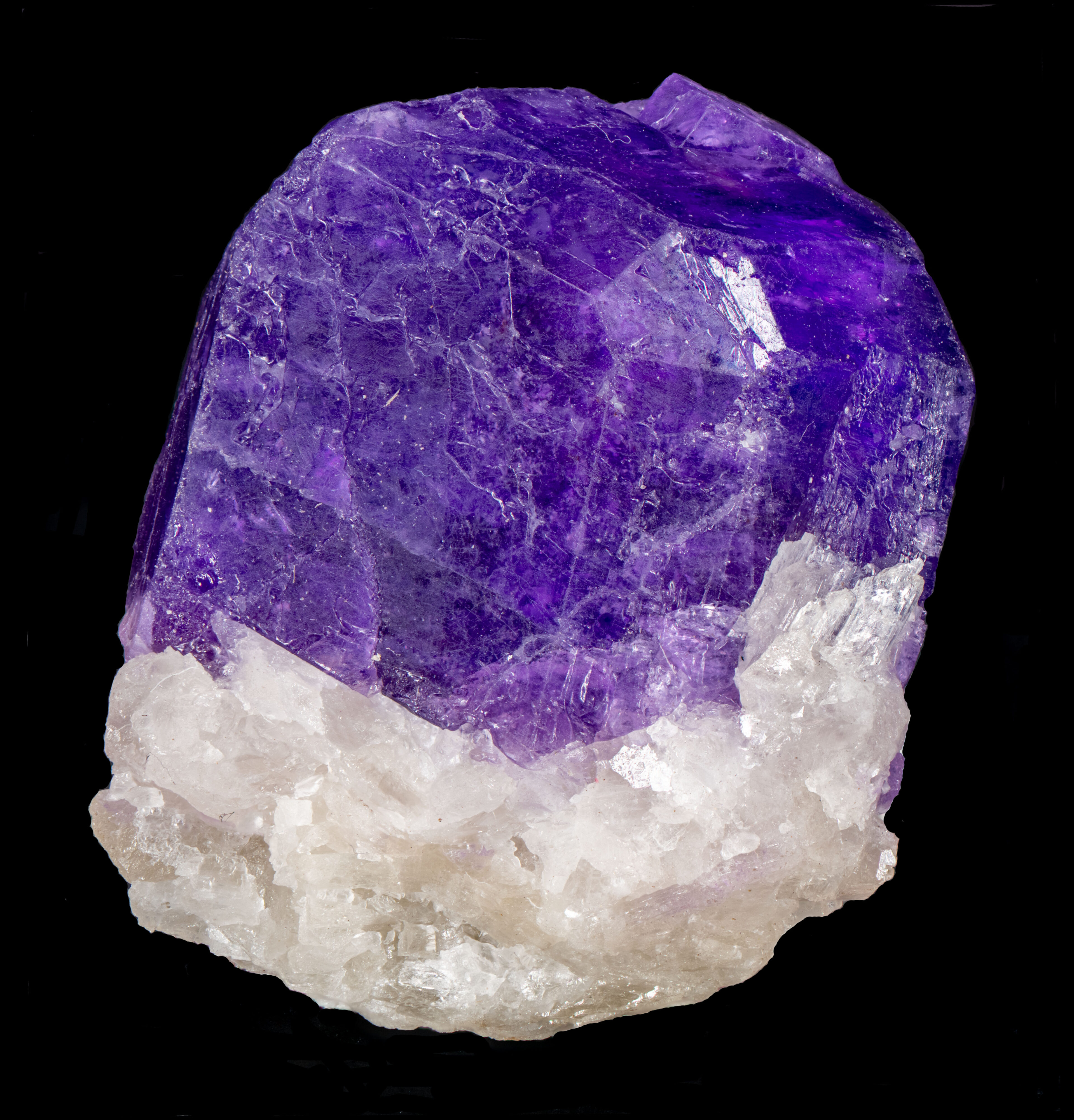Hackmanite Crystal from Afghanistan
Contributed by: Michael Crawford
Date: Jun 7th, 2025
Locality: Sar-e-Sang, Kuran wa Munjan District, Badakhshan, Afghanistan (See on Mindat)
Size: 2.5 x 3 cm
Description:
This is a small gemmy sodalite var. hackmanite crystal from Sar-e-Sang, Badakhshan Province, Afghanistan. The specimen also contains fluorescent calcite and richterite. The hackmanite crystal contains several atomic substitutions and defects that activate fluorescence, phosphorescence, and tenebrescence. The definitive fluorescent activator is uncertain in several examples seen in this crystal.
Disulfide ions (S2 -) replace chlorine ions to activate the yellow orange LW fluorescence. The spectrum of LW fluorescence contains a broad peak with smaller peaks superimposed on it. The smaller peaks are referred to as vibronic peaks and are caused by the vibration of the two sulfur atoms in the disulfide ion. The LW fluorescent spectrum also shows a small broad peak with a maximum at 440nm. This weak fluorescence is probably activated by dioxide ions substituting for chlorine.
The MW fluorescence of hackmanite is pinkish-white, and the SW fluorescence is bluish white. The spectra of MW and SW fluorescence is dominated by a peak with a maximum around 445nm. This fluorescence may be activated by titanium substituting for aluminum and a missing adjacent oxygen atom. The titanium substitution and oxygen vacancy are known to cause the strong blue-white afterglow seen in this crystal. Electrons are trapped in the oxygen vacancy during MW and SW illumination, and they slowly return to their ground state causing the afterglow when the UV light is turned off. It is likely that the cause of MW and SW fluorescence is also this titanium-oxygen vacancy. The pinkish hue of the MW fluorescence is from diminished fluorescence of the disulfide activated yellow-orange fluorescence combined with the blue-white fluorescence. The SW fluorescent spectrum has a subtle peak around 490nm. This peak might be activated by manganese (Mn2+) substituting for sodium.
The MW red fluorescence of calcite is activated by manganese and its SW fluorescence is co-activated by cerium and manganese. Cerium activation causes ultraviolet fluorescence around 340nm and that fluorescence triggers the manganese activated red fluorescence. The activation for the richterite yellow-brown SW fluorescence is uncertain. It may be manganese, titanium, or something else.
The tenebrescence is very strong in this hackmanite crystal. Tenebrescence is caused by a defect where some chlorine ions are missing from the sodalite crystal lattice. Tenebrescence also requires that an adjacent chlorine ion is replaced by an ion that can donate an electron when exposed to UV light. The disulfide ion is the most common donor replacing chlorine to activate tenebrescence.
This crystal becomes tenebrescent when exposed to all wavelengths of UV illumination. When UV light illuminates hackmanite, it causes an electron to be transferred from the disulfide ion to the vacant chlorine site. The result of an electron being transferred is the creation of an F-center (from the German word \"Farbzentrum\", where Farbe means color, and zentrum means center). The electron remains trapped in the F-center after the UV light is turned off. When visible light strikes the F-center, it absorbs the green wavelengths of visible light and some of the blue and red wavelengths. The maximum absorption is at 550nm. Visible light reflected from the tenebrescent specimen contains blue and red wavelengths to produce a purple color. Exposure to light or thermal energy causes the trapped electrons in the F-centers to transfer back to the adjacent cages with the donor ions and the purple color fades away. The fading of the purple tenebrescence is very slow in this crystal and most hackmanites from Afghanistan. It takes several hours to bleach the tenebrescence in this crystal under an intense halogen lamp. Hackmanites from Greenland and elsewhere fade in normal room lighting in a few seconds to minutes. I have never seen an explanation for this difference. Repetitive cycles of UV exposure and then bleaching the purple color does not diminish the intensity of the tenebrescent.
F-centers also modify the LW fluorescence of hackmanite. The spectrum of the hackmanite crystal shows the red shift of 40nm compared to the spectrum of a Greenland sodalite. This red-shift is primarily the result of the F-centers that cause the tenebrescence also absorb shorter wavelengths of the LW fluorescence. The maximum tenebrescent (F-center) absorption is at 550nm so the shorter wavelengths of the disulfide activated are attenuated.
The last image compares SW fluorescence pictures taken with 257nm LED and 254nm tube illumination. The SW tube has many extra emission lines in the ultraviolet (300nm to 400nm) that cause LW yellow-orange fluorescence in addition to the SW fluorescence.
Summary of luminescence responses:
Sodalite (Mindat) (RRUFF)
- Fluorescence under Longwave (365nm LED) UV light: Orange
- Fluorescence under Midwave (305nm LED) UV light: White
- Afterglow after exposure to Midwave (305nm LED) UV light: White
- Fluorescence under Shortwave (255nm LED) UV light: White
- Afterglow after exposure to Shortwave (255nm LED) UV light: White
- Tenebrescence after exposure to Shortwave (255nm LED) UV light: Purple
- Fluorescence under Midwave (305nm LED) UV light: Red
- Fluorescence under Shortwave (255nm LED) UV light: Red
- Fluorescence under Shortwave (255nm LED) UV light: Yellow










